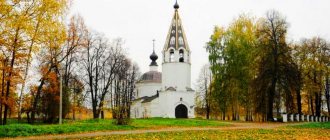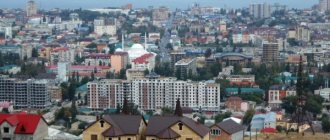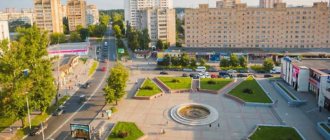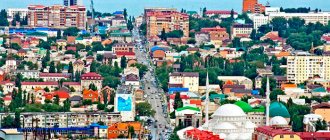Clean air, beautiful nature, rural silence and the spirit of Rus', rarely found today - all this is a city of antiquity and landscapes loved by tourists and travelers, the city of Ples, located in the Ivanovo region.
The city of Plyos lies on the route between the cities of Ivanovo and Kostroma, if you follow the route of the Golden Ring of Russia. Although Ples is not officially part of the Golden Ring of Russia, here you will definitely have something to visit and admire. The city has many popular tourist attractions, architectural and cultural monuments, most of them ancient. Old Russian churches are especially beautiful. Many people come to Plyos just to take a break from noisy cities.
Assumption Cathedral (Cathedral of the Assumption of the Blessed Virgin Mary)
- Address: Plyos city, Sobornaya Gora street
- Coordinates: 57.4584282 41.515556
The Cathedral of the Assumption of the Blessed Virgin Mary is located on Cathedral Hill. The wooden ancient Russian temple located on this site burned down at the end of the 17th century. In its place a new temple was erected, which was called the “winter temple.” The Assumption Cathedral is the most ancient landmark of urban architecture. In Levitan's painting (“The Quiet Abode”) you can see this temple as it was in ancient times.
What to see in Ples in 1 day – TOP-3
There are not too many attractions in the city, but those that exist deserve attention, that’s for sure. What to see on your own in Plyos first?
Cathedral of the Assumption of the Blessed Virgin Mary
- Address: Sobornaya Gora street.
The building of the Assumption Church is considered the oldest religious site in Plyos. It was built on the site of a wooden cathedral complex damaged by fire. Erected in 1699, the stone church acquired a new altar a century later. At the beginning of the 19th century, a tented bell tower also appeared here.
Somewhat later, in 1824, a chapel was erected near the Holy Assumption Church. Four years later, the Kazan summer temple was built. The money for this was allocated by local tradesman V. Shishkin. The resulting complex was surrounded by a brick fence. A gate was placed on the south side.
According to its architectural style, the religious building is classified as a provincial version of Russian Baroque. The winter part of the ensemble, the Assumption Cathedral, has survived to this day. The gates that were part of the church fence also survived. Restoration work is underway in the church. It is planned to restore not only the building itself, but also its interior decoration.
House-Museum of I. Levitan
- Address: st. Lunacharsky, 4/1.
A memorial dedicated to the outstanding landscape artist was opened in 1972. The museum dedicated to him was located in the former house of the merchant Solodovnikov. Here Levitan lived and worked in 1888-1889. In just three seasons spent in Plyos, the master managed to write about 200 works.
Among the works were 23 paintings, many sketches and sketches. The most significant paintings from the “Plyos period” can be called “Quiet Abode”, “Evening. Golden Reach”, “Above Eternal Peace”.
The museum exhibition includes 3 sections. They talk about the artist’s biography, highlight his life in a town on the Volga, and introduce him to his personal belongings displayed in a separate showcase.
The basis of the museum’s collection of the artist’s works were canvases donated by a collector from Moscow , Felix Vishnevsky. Many exhibits were purchased from private individuals. The museum contains not only Levitan's paintings. Here you can also find works by his friends - A. Stepanov and S. Kuvshinnikova.
Plyos embankment
- Coordinates on the map: 57.460348, 41.518615.
Of course, it simply cannot be ugly on the banks of the Volga. Tourists really like it in Plyos, on its river embankment, as do the residents of the town and region itself. Almost the entire street is literally dotted with ancient houses and mansions, dachas that once hosted distinguished guests.
The Ples embankment also delights those who wish with numerous attractions, in particular, boat trips along the Volga, which are offered almost everywhere. Reviews also indicate that in the local shops you can buy delicious smoked fish, such as bream, excellent pies, and a variety of souvenirs.
Plyos State Historical, Architectural and Art Museum-Reserve
Here you will see a complex of monuments of architecture, culture, art and history. The complex includes:
- Memorial House-Museum of I.I. Levitan
- landscape museum
- museum and exhibition complex “Public Places”
- exposition “Artistic crafts of the Ivanovo region”
- Levitanovsky Cultural Center
About 300 cultural and historical monuments, more than 20,000 objects of ancient Russian antiquity, folk art and art, ancient books, coins and, of course, drawings and paintings will be available to your eyes.
All the sights of Plyos: description and photos
Plyos is a small chamber town in the Ivanovo region. But it is rich in sights and interesting places: churches, museums, art galleries, sculptures, houses decorated with wooden carvings and even openwork gutters - all this is worth seeing! The best way to see the city is on foot. And don’t let the hilly landscape scare you, walking around Ples is pleasant and easy.
So let's begin!
The descent from the house-hotel "Volga-Volga" leads us to the bridge over the river. Shokhonka, we cross the river and along the street. Nikolskaya we are moving towards the Volga.
You should definitely stop at house number 20 on this street. Here is the Provincial ART Gallery-M. This private museum presents: USSR porcelain, Western European porcelain in the “nude” style, large-figure faience “Konakovo factory”, Russian varnishes, a gallery of paintings by V.A. Fedorov, Russian majolica, Leniniana, portraits of the 20th century. Founder of the gallery Marushkin Yu.B. will lead an interesting excursion. You will not regret!
Near the gallery, an artist sat on logs, looking into the distance. This is a monument to the Honored Artist of the RSFSR, famous landscape painter, native of Ivanovo-Voznesensk, Vyacheslav Fedorov.
Opposite the gallery, a small street goes slightly uphill. Having taken a few steps along it, you can see the sculpture of the Policeman, a guard, respectfully awaiting the arrival of the owner or his guests and keeping order in the area.
The next house (number 18) on Nikolskaya Street is the Gallery of the artist L. Nikolaev “Painting and Graphics”. The landscapes of this painter are interesting for their romantic vision of nature, freedom of plastic expression, complexity, softness and integrity of the color structure of the sheet.
Continuing our descent to the Volga, at the intersection with Varvarinskaya Street we see the St. Nicholas Chapel, built in 1892. It is a classic example of chapels in central Russia. Currently not operational.
And here we are on the banks of Mother Volga!
On the left there is a monument to I.I. Levitan, the famous Russian artist, master of “mood landscape”. Fascinated by Plyos, Levitan spent the summer of 1888 here, and then came here for two more subsequent seasons.
Opposite the monument is the house-museum of I.I. Levitan. The museum's exhibition includes two halls: the first is dedicated to the creative biography of the artist, the second houses original works by I.I. Levitan and his friends. On the mezzanine there is a room where the artist and his friends lived.
Passing by the house-museum of I.I. Levitan and moving to the right along the embankment, we reach the Levitan Cultural Center or Levitan Hall. Film screenings, conferences, seminars, concerts and many other cultural events are held here.
Further along the embankment (Lunacharskogo St., 20) is the only landscape museum in Russia. Exhibitions of contemporary landscape painting from Russian regions, the Plyossky Plein Air festival and the Volga Artist children's plein air exhibition are regularly held here.
Opposite the museum, a young girl “Summer Resident” is sitting on a bench. It is assumed that the prototype of this sculpture was the companion of I.I. Levitana, artist S.P. Kuvshinnikova.
Another interesting sculpture can be seen by walking further along the embankment, past the city beach to the “My Pier” house-pier. This is a sculpture of the Boatswain, a figure of a riverman similar to Captain Vrungel.
Not far from Botsman, near the Itil hotel, there is the Zelenya Old Believer cemetery, established at the end of the 17th century. Now it is closed, and only small overgrown hills remind that there was a cemetery here.
Returning to the Landscape Museum and going up a small street up from the Volga, we see the Church of Barbara the Great Martyr. The construction of the temple dates back to the beginning of the 18th century, and the current bell tower was built in 1821. This church is depicted in the painting by I.I. Levitan "Evening. Zolotoy Plyos".
Behind the Varvarinskaya Church, Kirova Street goes up. Having climbed it, we find ourselves at the beginning of the Levitan trail, a wooden staircase 168 steps long. Climbing the stairs is not difficult: there are several rest areas with comfortable benches.
Having overcome all the steps, we find ourselves on Mount Levitan.
There is a whole sculptural complex installed here, opened several years ago. It includes a bronze sculpture of the artist standing in front of an easel, as well as (a little further away) a copy of the artist’s work “Above Eternal Peace” in a bronze frame.
On Mount Levitan, behind a small fence, there is the Resurrection Wooden Church. This is a wooden cage church (1699), erected on the site of the burnt cemetery church of Peter and Paul. The lost church is depicted on the canvas by I.I. Levitan "Above Eternal Peace".
A worship cross was erected in memory of all those buried in this ancient cemetery.
Having walked around the entire Levitan Mountain, along Vichugsky Passage you can go down to the bridge over Shokhonka. If your energy is running low, be sure to stop by the Volga-Volga house-hotel and drink a cup of invigorating tea or coffee on the open veranda.
Strength restored!
Now our path lies to Cathedral Mountain (height 54 m above sea level). We go up the street Descent of Mount Liberty.
In house number 1a there is the P. Travkin Archaeological Museum. Here you can take a short trip into the distant past, here each item is reproduced reliably, based on archaeological data.
We are at the top of the mountain. From here the city began to grow. Prince Vasily I, the son of Dmitry Donskoy, in 1410 ordered the foundation of a defensive fortress here. The river in this place flows along a straight stretch of almost 2 km. And all approaches to the city are clearly visible.
Fortress walls, a rampart and a moat were built. Unfortunately, the fortress walls and moat have not survived. And fragments of the fortress rampart can be seen from the side opposite to the Volga.
From the fortress rampart there is a view of the Trinity Settlement, located at the entrance to the city, and of the temple complex, consisting of two churches: the Winter Vvedenskaya and the Summer Trinity. The Vvedenskaya Church was first made of wood, and in 1828 it was built of stone. Adjacent to the temple is a long, low refectory. Trinity Church was also built first in wood in 1628, and in 1808 in stone.
In the center of Cathedral Hill is the Assumption Cathedral. This is the oldest temple in the city (1699), it still operates in our time and amazes guests of the city with its “crimson” bell ringing.
Behind the cathedral we see a monument to Prince Vasily I. The installation of the monument in 1910 became a serious event for the city: even the capital’s newspapers wrote about the celebration that took place in a small provincial town.
Next to the monument there is an exhibition complex “Public Places”. The permanent exhibition of the exhibition complex is dedicated to the historical development of Plyos. Other exhibitions are changing, usually timed to coincide with events in the cultural life of the city.
In the Public Places there is an unusual exhibit, the Stone of Love, which got its name due to its unusual shape.
A birch alley winds along the perimeter of Cathedral Hill. The age of birches reaches 150 years. This is a very popular place for walking for both local residents and visitors to the city.
At several points on the top of the mountain there are observation decks and comfortable gazebos where you can hide from the sun and rain.
Having completed the inspection of Cathedral Mountain, we go down the rocky street, where even on a hot afternoon it is cool and comfortable. Trees growing along the path provide protection from the heat. We turn left...
And here we are at Trade Square. This is the central (and only) square of the city. Since ancient times, lively trade took place here and fairs were held. Now there are shops with souvenirs for every taste.
At the intersection of the street. Yuryevskaya stands with the fire department building, built in 1885. The fire station was located on the first floor, the police station and prison cells were on the second.
In the eastern part of the square, at the intersection with the street. Lenin stands the Chapel of the Archangel Michael. This wooden “cage” chapel was brought from the village of Antonovo in the 1980s. and restored.
Opposite the chapel, the Church of the Resurrection of Christ is majestically located. The church was built in 1817 on the site of two wooden churches. They decided to replace the old churches with new ones in memory of the victory of the Russian people in the Patriotic War of 1812.
On the opposite side of the square from the Resurrection Church we see the entrance to Kalashnaya Street, the oldest shopping street in Plyos, the first mention of which dates back to 1787.
Going down from Torgovaya Square, we go out to the Volga embankment. To the right along the embankment are ancient mansions built from the late 18th to the mid-19th centuries. Almost each of the mansions belonged to some famous family in Plyos and has since then been named after them.
Turning left from Torgovaya Square, we find ourselves on Plyossky Vernissage, the alley of artists. In the summer, here you can view and purchase works by Plyos artists and products by masters of applied art. In winter, snow figure competitions are held on the alley.
Here on the embankment there are Meat (lower) shopping arcades and the Vekshina teahouse. The house was built in the second quarter of the 19th century. in the style of provincial classicism. On the ground floor there was a large hall of the Vekshin teahouse.
We recommend visiting the exhibition “Art Crafts of the Ivanovo Region” in the building of “Flour Rows”. You can see examples of jewelry, linen jacquard weaving, lacquer miniatures, as well as original Ivanovo embroidery.
A little further along the embankment (Sovetskaya St., 49) there is a private gallery “Exhibition Hall on the Embankment”. The works of artists of the Ivanovo region, including Plyos artists, are presented here.
Don’t be too lazy to walk along the embankment. On the street Lenina, 26 (entrance from the embankment) you will see the art studio of Vitaly Panchenko. Vitaly Panchenko is a Russian artist, a member of the Creative Union of Artists of Russia, one of the founders of the creative organization “Community of Plyos Artists”.
Opposite the art studio, almost right next to the water, there is a stone, and on the stone is a cat, constantly looking at the Volga. The monument was erected in honor of the cat Mukha (the owners are the Plyos artist V. Panchenko and his wife Galina). A cat died protecting her kittens from angry dogs.
Ostrovsky Street goes up a little from Koshka. After walking along it, you will come to the Church of the Transfiguration. This cemetery church (1849) was built in the classicist style on the site of the Transfiguration Monastery through the diligence of benefactors.
In the city of Ples there is another mountain, Voskresenskaya. There is a memorial to the soldiers who died in the Great Patriotic War.
- Plyos artistic
- Ples - a pearl on the Volga
Museum and exhibition complex “Public Places”
- Address: Sobornaya Gora street, 1
- Coordinates: 57.458878, 41.514067
Not far from the Assumption Cathedral is located the Museum and Exhibition Complex “Public Places”, it is part of the complex of the museum-reserve of the city of Ples. At the entrance you will be greeted by a monument to Vasily I. The building was built in 1786, here once was the city government, the Higher Primary School for Men, and the City Public Bank. In the 18th century, wine was stored under the vaults of the basement, and then the archives of the City Government of the city of Plyos were located here.
Currently, there are exhibitions on two floors, but in the basement there is an exhibition “Ancient Ples and Ivanovo Land”. The exhibition displays items from the unique “Alabuga Treasure” - a set of women’s jewelry that was sacrificed during the construction of the fortress rampart of the Penkovsky settlement in the 7th century. AD..
Varvarinskaya Church (Church of St. Barbara) city of Plyos
- Address: Plyos, st. Uritskogo, 22
- Coordinates: 57.458439, 41.528131
The Varvara Church plays a special role in the ancient architecture of Plyos. Its snow-white walls somehow decorate the city in a special way. The church was built in classical style in the 17th century.
Wedding Museum
- Address: st. Descent of Mount Freedom, 7
- Coordinates: 57.457194, 41.517554
- Phone: 8 (49339) 4-36-62
In the hut of a wealthy pharmacist living in Plyos there is a “wedding museum”.
The pharmacist had several daughters. When his daughters got married, he arranged unforgettable weddings for them, like many residents of the city. Since then, it has become a custom for those living near the city to hold their weddings in Plyos.
In the Wedding Museum you will see many exhibits that are in one way or another connected with wedding ceremonies held in the old days (girls’ dowries, interior items, things). They will tell you about the intricacies of holding weddings in this area, about how they used cunning to make a profitable marriage. All the stories you will hear are based on real stories of people living in the city and its environs.
“Plyos cat” and “Summer resident”, sculptures for the 600th anniversary of the city
- Address: st. Lunacharsky, landscape museum on the Volga embankment
- “Dachnitsa” coordinates: 57.4589741, 41.5281364
- Coordinates of the “Plyos cat”: 57.462676, 41.504070
On the embankment near the Church of St. Barbara, next to the pier where part of the “Cruel Romance” episodes were filmed, you will be greeted by two new sculptures that have become new attractions of the city, “Plyos Cat” and “Summer Resident”.
The sculpture “Summer Resident” was installed in honor of the 600th anniversary of the founding of the city of Plyos in 2010. “Summer resident” personifies the “dacha” times that entered local history from the second half of the 19th century. In those days, local residents often rented out their houses for the summer. This sculpture depicts a girl looking into the distance of the Volga River through an easel. Looking at the “canvas” of the easel you can see a magnificent landscape.
Landscape Museum
- Address: st. Lunacharsky, 20
- Coordinates: 57.458934, 41.529211
- Phone: 8(49339) 4-32-65, 4-34-90, 4-32-64
The Museum of Landscape, the first museum in Russia, which presents the history of the development of Russian landscape painting. It contains paintings by famous artists Levitan and Shishkin, as well as paintings by contemporary authors.
Annual festivals are held here, where young and young masters can show their works next to the masterpieces of famous artists.
Phantom of the Museum
The story goes that the Old Believer merchant, who built the mansion that became the home of the museum, at one time married a girl, Anna Grosheva, and together with his mother tried with all his might to convert his wife to his faith. The house had strict rules and regulations that she had to follow. But one day Isaac Levitan came to the city with his passion Sofia Kuvshinnikova, they met a young merchant’s wife and encouraged her to go with them to the capital city. So Anna ran away from her unloved husband and evil mother-in-law.
The Landscape Museum has gained fame not only as a place that can bring aesthetic pleasure, but also as a place that can frighten, because, as the locals say, a ghost lives in it.
Anna Grosheva was not seen in Plyos for a long time, but many years later, when she was no longer there, she returned to the house where it had once been so difficult for her, in the form of a ghost who now wanders around the building. This is confirmed by the testimony of museum employees, who claim that handfuls of sawdust strangely appear in a closed display case and on the tables in the halls. No one can explain this rationally, and only one conclusion was drawn: these sawdust are nothing more than the tricks of a ghost.
“Russian House”, archaeological museum, Museum-estate of an ancient Russian family
- Address: st. Freedom Mountain Descent, 1
- Coordinates: 57.4569496, 41.5156737
- Phone: 8 (49339) 4-33-06,
- Opening hours: 10:30-16:00.
- Website: https://www.travkin-museum.ru
In the “Russian House” you will find yourself in a complex of buildings and premises whose architecture is made in the ancient style. This is not a simple museum with ancient exhibits, but a recreated house of the medieval town of Ples. The museum was created according to evidence found during archaeological excavations from the 13th century.
So in the museum of the ancient Russian family on the territory of the center, life in 1237 is shown. It shows a jewelers' house that once existed in that place, according to the finds. Later in 1238, during the Horde invasion, the house was burned.
When you enter the territory of the archaeological museum, everything seems real. To enhance this feeling, you can fully immerse yourself in antiquity by working on a real potter’s wheel, turning hand millstones, weaving on a vertical loom, while wearing ancient Russian costumes. You can also feel like an ancient Russian defender by wearing chain mail and picking up a real sword.
All this was invented by candidate of historical sciences P.N. Travkin. He wanted everyone to be able to travel back in time, as if in a time machine. In the museum you can take pictures with any exhibits. Photo sessions in the image of medieval Rus' will be unforgettable. Many things and historical books can be bought here.
Monument to Levitan
- Address: st. Lunacharskogo, 4/2
- Coordinates: 57.459413, 41.523174
Once upon a time, the great Russian artist Isaac Levitan lived and worked in the city of Plyos. In memory of him, a monument was erected near the Levitan Museum. The figure of the monument faces into the distance towards the great expanses of the Volga. Levitan adored the Volga, which is skillfully reflected in his unique canvases. The Levitan monument holds a palette in one hand, and he presses the other hand with a brush to his heart, admiring the beautiful view spread out before his gaze.
Attractions in the vicinity of Plyos
Near Plyos there are several preserved estates. Retiring military men and nobles who moved here from the capital lived here; F. Chaliapin acquired a dacha in these places.
Estate "Alekseevskaya"
- Address: s. Nogino.
The estate is located in the village of Nogino, 6 km from Ples. The estate was built between 1785 and 1800. Its owner, a retired guards officer, built a mansion in the style of the famous park in Petrodvorets.
In the center of the estate is the master's house, surrounded by a park that gradually turned into a real forest. A four-row alley leads to the house, which was used to receive guests arriving at the house. Numerous alleys and paths scatter throughout the park.
The area of the estate is small - less than 10 hectares, but a large pond (more than 11 hectares) visually expands the perimeter. The dacha seems even larger due to its harmonious fusion with the fields and copses surrounding the landmark.
Estate "Quiet Marina"
- Address: 4 km south of Plyos.
Downstream of the Volga, 4 km from Plyos, is the Quiet Marina estate. The estate was built on the high and steep right bank of the river. The coastal hills are cut by ravines and are overgrown with dense mixed forest.
The estate itself “runs down” from the height of the hill along its slope to the river. The estate is bordered on both sides by ravines. They are a natural boundary, dividing the mansion with neighboring properties.
The western side of the “Quiet Pier” borders the Maksimtsevsky ravine, from the east the estate is limited by the Khmelitsky ravine. Once upon a time, the estate was adjacent to F. Chaliapin’s dacha “Khmelnitsy”.
Dacha F.I. Chaliapin
- Address: Shalyapino village.
In 1910, the outstanding singer traveled along the Volga with the artist Klodt. Chaliapin was imbued with the beauty of these places and decided to purchase an estate here. Architect S. Kuznetsov developed the project. The singer finally approved it in 1912.
The small estate of Khmelnytsia becomes the singer’s dacha, where he wanted to live after completing his artistic career. But the dreams of the great bass were not destined to come true. In 1918, he was confirmed as artistic director of the Mariinsky Theater, and the Soviet authorities nationalized his estate. Later it housed a rural commune and a home for starving children of the Volga region.
In 1923, the dacha was expanded with various extensions. The Poroshino holiday home was created on this site. Near the library, in the left wing of the building, a room-museum of the famous singer was organized.
See reviews of other cities in the Ivanovo region - Gavrilov Posad, Shuya, Yuryevets, Palekh and Kineshma
Ples is probably one of the smallest cities, if not in all of Russia, then in the Ivanovo region for sure. Its area is only about 3 square meters. km, and the population is approximately 2 thousand people. But it’s rare to find so many historical and cultural treasures in one place. Probably, like no other, the Russian proverb applies to Plyos - “the spool is small, but dear.”
Memorial House-Museum of Levitan
- Address: st. Lunacharskogo, 4/2
- Phone: 8 (49339) 4-34-78, 4-34-90, 4-37-82
- Coordinates: 57.459402, 41.523630
This is the same house in which Levitan painted his paintings. Here they will show you his works and tell you his biography. You will learn about how the greatest artist lived and worked. In this house-museum, the furnishings of the times when I.I. lived here have been preserved as much as possible. Levitan.
The museum presents the works of not only the great artist, but also the works of such artists as Kuvshinnikova and Stepanova.
Exhibitions and expositions
The pearl of the museum is, of course, its permanent exhibition, which presents unique creations by artists R. G. Sudkovsky, V. V. Perepletchikov, V. D. Polenov, N. A. Yaroshenko, N. N. Dubkovsky and other masters of the brush. Works by artists who were Levitan's friends are also exhibited. The museum collection is constantly updated with paintings by contemporary creators, and in the museum itself many creative personalities meet, communicate and argue about art.
The Landscape Museum regularly organizes artist festivals and exhibits contemporary landscape paintings from various regions of Russia.
The nature of Plyos gives inspiration and new themes to painters who try to convey their vision of the surrounding beauty, understanding and depicting centuries-old pictures of nature in their own way. But Mother Nature is timeless and is in constant activity - she is eternal, which means her motives are truly inexhaustible.
Museum visitors are introduced to the history of the development of Russian landscape painting, various landscape genres and their specifics, and also talk about how outstanding landscape artists lived and worked.











